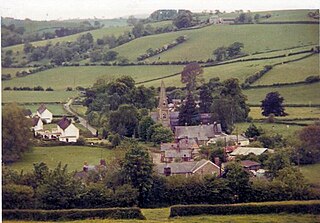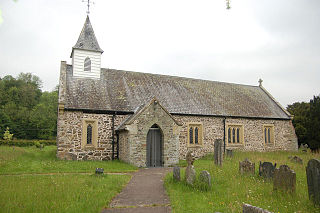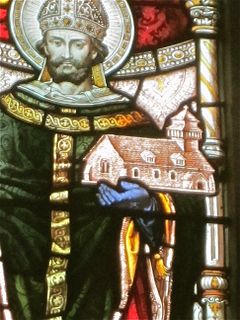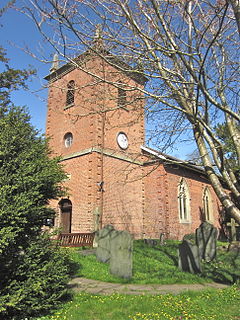
Montgomeryshire, also known as Maldwyn is one of thirteen historic counties and a former administrative county of Wales. It is named after its county town, Montgomery, which in turn is named after one of William the Conqueror's main counsellors, Roger de Montgomerie, who was the 1st Earl of Shrewsbury.

Newtown, the largest town in the county of Powys, Mid Wales, lies on the River Severn in the community of Newtown and Llanllwchaiarn, within the historic boundaries of Montgomeryshire. It was designated a new town in 1967 and saw population growth as firms settled, changing its market-town character. Its 2001 population of 10,780 rose to 11,357 at the 2011 census. It was the birthplace of Robert Owen in 1771, whose house stood on the present site of the HSBC Bank. The town has a theatre, Theatr Hafren, and a public gallery, Oriel Davies, displaying contemporary arts and crafts.

Abermule is a village lying on the River Severn 6 km northeast of Newtown in Powys, mid Wales. The A483 Swansea to Chester trunk road, the Cambrian Line railway, connecting Aberystwyth to Shrewsbury, and the Montgomery Canal, close to the river, all pass through Abermule. The village had a population of 900 as of the 2011 census.

Berriew is a village, community and electoral ward in Montgomeryshire, Powys, Wales, on the Montgomeryshire Canal and the Afon Rhiw near the confluence with the River Severn at grid reference SJ185005, 79 miles (128 km) from Cardiff and 151 miles (243 km) from London. The village itself had a population of 283. and the community also includes Garthmyl Hall and Refail.

Pontrobert is an ecclesiastical parish that was formed in September 1854. It comprises the townships of Teirtref and part of Nantymeichiaid in the parish Meifod, a portion of Cynhinfa which was in the parish of Llangynyw and portions of the townships of Fachwel, Llaethbwlch and Cadwnfa which were in the parish of Llanfihangel. The total area of this parish is 5,000 acres. As a result of this arrangement, Pont Robert is now divided between the present day Community Councils of Meifod, Llangyniew and Mawddwy. Pontrobert was within the historic county of Montgomeryshire, now forming part of Powys. The name Pontrobert is derived from Robert ap Oliver of Cyhinfa, who built the original bridge over the River Vyrnwy around 1700. An alternative Welsh name for Pontrobert is Pont y ddolfeiniog.

Tregynon is a small village and community in Montgomeryshire, Powys, Wales, to the north of Newtown and south west of Welshpool. The population of the community was 892 at the 2011 Census. It rests on the B4389 road which runs from Bettws Cedewain to New Mills. The country house Gregynog is nearby.

Thomas Penson, or Thomas Penson the younger was the county surveyor of Denbighshire and Montgomeryshire. An innovative architect and designer of a number of masonry arch bridges over the River Severn and elsewhere. He was the son of Thomas Penson the older,, who had been the county surveyor for Flintshire from 1810 to 1814, but had been dismissed when the bridge at Overton-on-Dee collapsed. Thomas Penson the younger, completed its replacement. Thomas Penson the younger had two sons: Thomas Mainwaring Penson and Richard Kyrke Penson, both of whom were architects and both practised in Chester

Aberbechan was formerly a township in the parish of Llanllwchaearn in the historic county of Montgomeryshire. The township of Aberbechan was transferred to Bettws Cedewain and more recently moved, together with the township of Dolforwyn, into the community of Abermule and Llandyssil in Powys, Wales.

Llandyssil is a village in Powys, Wales, about two miles from the town of Montgomery.
The Deanery of Cedewain is a deanery within the Archdeaconery of Montgomery in the Diocese of St Asaph. It is a large largely upland area between Welshpool and Newtown, which is cut across by the river Severn. It is first mentioned in the Lincoln Taxation of 1291. At that time it consisted of the parishes of Berriew, Bettws Cedewain, Manafon, Llanwyddelan, Tregynon, Newtown, Llanllwchaiarn, Llanmerewig, Llandyssil, and Aberhafesp. The Deanery was reconstituted by an Order in Council in 1849 and further changes in its boundaries occurred in 1882. In 1908 it consisted of eleven parishes: Aberhafesp, Bettws Cedewain, Dolfor, Kerry, Llandyssil, Llanllwchaiarn, Llanmerewig, Mochdre, Newtown, Sarn and Tregynon. For administrative purposes Llandyssil is now included in the Deanery of Pool.
Archdeaconry of Montgomery. An Archdeaconry within the Diocese of St Asaph. It covers the eastern area of Montgomeryshire and includes Welshpool, Newtown, and Llanfyllin. Originally part of the Archdeaconry of Powys, which dated from the Medieval period. The Archdeaconry of Powys was reconstituted by an Order in Council in 1844, when it was split into the Archdeaconry of Montgomery and the Archdeaconry of St Asaph. In recent years the Archdeacon has lived in 17th century half-timbered Vicarage at Berriew. .

Manafon is a small rural community located in the hills of Montgomeryshire, the Northern part of the Welsh county of Powys. The Parish focuses on the valley of the River Rhiew that runs west to east into the River Severn". The community of Manafon consists of "two main villages within about a mile of one another, Manafon and New Mills. The remainder of the population lives in scattered farms and dwellings and in the small rural settlement of The Green."

Saint Tysul was a 5th-century pre-canonical saint and patron saint of the churches of Llandysul in Cardiganshire and Llandyssil in Montgomeryshire. Tysul’s full name was Tysul ap Corun ap Cunedda – or son of Corun, son of Cunedda. His feast day is 31 January.

Fronfraith Hall is a mid-Victorian house in the historic parish of Llandyssil in the shire area of Montgomeryshire in Powys. Fronfraith also appears in records as Bronfraith and Vronvraith. Fronfraith was also a township within the parish of Llandyssil. The present house was built in 1863 under the supervision of the Shrewsbury architect James Pickard This house replaced a large house, probably a half-timbered Tudor mansion, which had been the home of the Morgan family. In 1966, the west wing of the Fronfraith Hall was badly damaged as the result of a fire, but has now been restored. The Hall is now partly used as a guest house.

Aberbechan Hall was a timber framed mansion in the township of Aberbechan within the parish of Llanllwchaearn in the historic county of Montgomeryshire. The township of Aberbechan was transferred to Bettws Cedewain and more recently moved, with the township of Dolforwyn, into the community of Abermule with Llandyssil. The Hall was originally built by the Blayney family, passing to the Price and Lloyd families, before becoming the property of Sir Gervais Clifton. In 1810 it was sold to David Pugh of Llanerchydol near Welshpool. The Hall was demolished in 1870 and replaced by the present Hall.

St Beuno's Church, Bettws Cedewain lies within the historic county of Montgomeryshire in Powys. The church occupies a prominent position overlooking the village of Bettws Cedewain, on the northern edge of the valley of the Bechan Brook which flows into the River Severn. Bettws is about 9 miles to the south-west of Welshpool. The church is a single-chambered structure with a western tower, set in a near-circular churchyard. A campanile or bellcote was added to the earlier tower in the early 16th century by the vicar, John ap Meredyth, whose memorial brass remains in the church to-day. The church was extensively rebuilt in 1868 under the supervision of the architect William Eden Nesfield. This included a complete rebuild of the upper part of the tower

St Llwchaiarn's church, Llanllwchaiarn was the parish church of Llanllwchaiarn, now within the community of Newtown with Llanllwchaiarn and lies within the historic county of Montgomeryshire in Powys. The church occupies a position on rising ground overlooking the river Severn and is to the north east of Newtown. The present church was rebuilt in 1816. In 2011 the medieval carved screen, originally from St Mary's church in Newtown, was re-positioned in Llanllwchaiarn church

Llanerchydol is a settlement on the A458 about 2 km west of the centre of Welshpool in the county of Powys in Wales. It is part of the community of Welshpool and also lends its name to an electoral ward.

Llandyssil is a community in Powys, Wales, including the villages of Abermule and Llandyssil, and had a population of 1527 as of the 2011 UK Census. It also includes settlements of Llanmerewig and Green Lane.

Mochdre is a small village and larger community in Montgomeryshire, Powys, Wales. The community includes Penstrowed and the much larger settlement of Stepaside. The community had a population of 494 as of the 2011 UK Census.
















